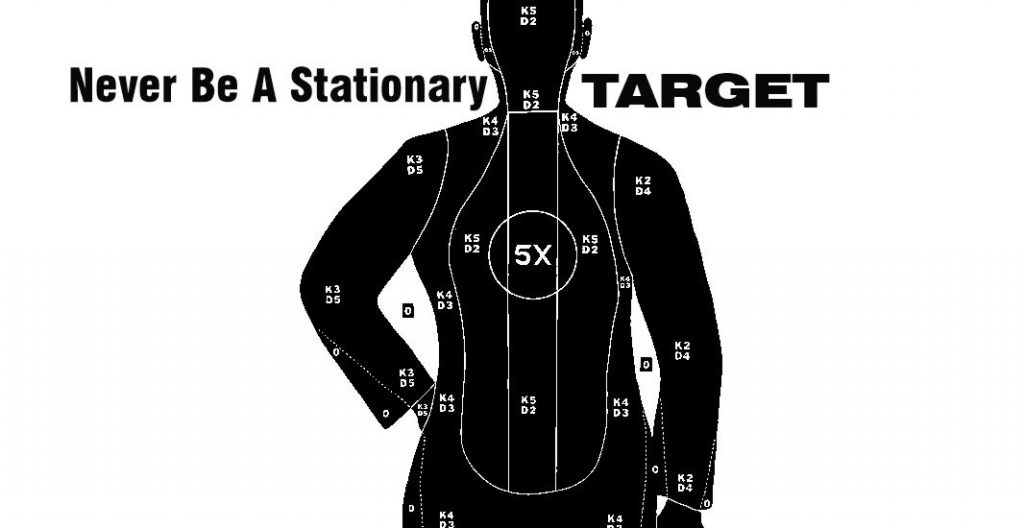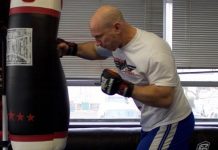
The single biggest distinction between fitness and martial arts training is whether participants move or remain stationary, and the key is learning footwork.
However they express it, the principle remains the same – You never want to be a stationary target.
In my last article, What is Self Defense?, I discussed how context of training determines technique, such as practicing against a stationary attacker when learning how to execute technique as opposed to practicing against a moving, resistant opponent when learning how to apply technique. The first situation is an example of training in the art while the second is training for self defense or sport. But regardless of context or style, there are certain principles that apply in any situation and found in any complete system. One of the main principles involves movement or footwork. Different styles or instructors express this principle in various ways: Don’t be there. Get off the tracks. Move to the pocket. Stay out of the center. However they express it, the principle remains the same – You never want to be a stationary target.
Practicing while you remain stationary is a different type of training than practicing with movement.
Just as practicing against a stationary attacker is a different context of training than practicing against a moving, resistant opponent, practicing while you remain stationary is a different type of training than practicing with movement. Nowhere is this difference more apparent than in the hottest variation of martial arts training currently sweeping the country, boxing and kickboxing based fitness. What began with LA and Title Boxing has now spawned countless variations including 9 Round and I Love Kickboxing. But regardless of the version, the premise remains the same: high intensity workouts consisting of alternating rounds of bag work interspersed with calisthenics and ab work. Not only has the success of these franchises helped generate a renewed interest in boxing, the workouts have proven so popular that many clients eventually express a desire to learn how to actually box.
Learning how to box or kickbox means learning how to move, and learning how to move requires footwork.
While the desire to learn actual boxing or kickboxing has been a blessing for both sports, if instructors are not careful they can easily find themselves with frustrated or injured clients. Because learning how to box or kickbox means learning how to move, and learning how to move requires footwork, which is a skill. And like any other skill, footwork requires instruction, practice, and patience, which is the exact opposite of what draws many clients to boxing and kickboxing based fitness in the first place. One of the attractions of boxing and kickboxing based fitness is its simplicity. When a client enters a facility for the first time they’re given wraps and gloves, often having the wraps done for them, and immediately start striking a bag. Little or no instruction is necessary, and the simplicity draws clients from all demographics.
As much fun as the fitness classes are, when clients attempt to make the move from fitness to actual boxing, the fun often comes to a screeching halt.
As much fun as the fitness classes are, when clients attempt to make the move from fitness to actual boxing, the fun often comes to a screeching halt as they are reduced to struggling beginners attempting to coordinate two left feet. I recently visited a popular gym on the west coast which offers both fitness and actual boxing classes. In the boxing class with me were a younger, athletically built young man and a large, older gentleman. Both men liked to throw hard, and the young man had fast hands, but when the instructor introduced what should have been a simple jab cross to the pocket followed by a pivot to the left, neither of them could do it. The instructor repeated his instructions several times as clearly and concisely as he could, but neither of the clients could follow them because they had never learned footwork. Not only did both clients’ lack of footwork leave them and the instructor clearly frustrated, when it came time to spar both clients tried to make up for their lack of movement by relying on speed and power, creating a dangerous situation for them and their sparring partners.
Many fitness facilities promote their classes as a way to learn self defense and many martial arts schools don’t teach footwork because either it takes too long to learn.
Unfortunately, this type of situation happens all too often because many fitness facilities promote their classes as a way to learn self defense and many martial arts schools don’t teach footwork because either it takes too long to learn or the instructors never learned it themselves. This is especially true for schools that promote their programs as a means of developing both fitness and self defense skills. You can’t have a high intensity workout if the instructor has to stop the class repeatedly to explain all the nuances of footwork such as balance, structure, and angulation, and then take the time for each individual to practice the movement. There are many footwork drills that eventually can be done fast enough to be included in a workout, but this is a situation in which you have to walk before you can run. It’s much easier, and keeps clients more fully engaged, to simply skip the footwork and allow clients to practice all of their techniques from a stationary position.
If footwork is not included at some point in their training clients are not learning actual boxing, kickboxing, or martial arts.
While stationary practice is fine for fitness or building hand/eye coordination, if footwork is not included at some point in their training clients are not learning actual boxing, kickboxing, or martial arts. No matter how fast a client’s hands become or how good a shape they get in, if they do not understand footwork their training never really moves beyond fitness. If clients do not know how to move, no amount of strength or assertiveness training will make up for the fact they are standing directly in front of an opponent, especially if they are going to compete. And it is not enough to simply tell them to ‘move’. If clients don’t understand how, where, or when to move, it is unlikely they will figure it out for themselves. What is far more likely is that they will grow frustrated and leave the program or injure themselves or their sparring partners in an attempt to make up for their lack of footwork.
As the traditional saying goes, “You punch with your hands but you box with your feet.”
Rather than waiting to add footwork until later so that clients can hit the ground running, including movement from the first day emphasizes its importance and helps develop proper structure. The fact that clients will have to coordinate their hands and feet does mean the learning curve will be longer and steeper. But reminding clients that footwork is the key to any sport often helps put things in perspective and reinforces the idea that they want to rely on their feet and not their hands. As the traditional saying goes, “You punch with your hands but you box with your feet.” Teaching footwork from the start also provides instructors with a much larger number of drills to include during class, which can help keep classes fresh and clients engaged. One reason some fitness boxing and kickboxing clients express an interest in learning the actual art is the fact that stationary training can grow boringly repetitive, no matter how many different techniques you include. Some clients will naturally want to further challenge themselves, and adding footwork opens up a whole new perspective to their training.
As mentioned previously, footwork is about balance, structure, and angulation, as well as rhythm and timing.
As mentioned previously, footwork is about balance, structure, and angulation, as well as rhythm and timing. Clients don’t have to learn a large number of steps to move effectively. A simple repertoire of shuffle, bump, and switch steps, as well as pivoting are more than enough to get clients started. As with any technique, how you step is as or more important than which one you do. Learning to drive off the rear leg rather than stepping and dragging the rear leg engages the hips and helps coordinate the hands and feet. Driving the hips also makes it easier to maintain balance and avoid over committing the head and shoulders, sometimes known as leading with the face or stepping in the bucket. Angulation is the idea that instead of stepping straight in or back, all movement is either lateral or at an angle. Every style has its own way of describing this, such as triangle, dragon, or serpentine stepping. Timing is perhaps the most difficult aspect to learn. It takes a great deal of practice to develop the feel necessary to understand when it’s safe to go forward and when it’s better to maintain distance or even disengage and reset.
If instructors do not have great footwork themselves, they can always show videos of fighters like Vasyl Lomachenko.
Teaching footwork does not have to be difficult, but it is going to take some time, practice, and patience. When clients get frustrated, it is the instructor’s responsibility to keep clients engaged and assure them that their struggles are completely normal and part of the learning process everyone must go through. This is always a good opportunity to demonstrate what good footwork looks like and just how great an advantage it creates over someone who does not move. If instructors do not have great footwork themselves, they can always show videos of fighters like Vasyl Lomachenko, whose footwork is so good he often makes other professional boxers look silly. While using Vasyl Lomachenko as an example may seem like emphasizing the exception rather than rule, if more schools included footwork in their clients’ training from their very first day, he would be the rule rather than the exception.










